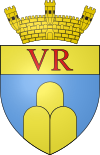Victoria, Malta
|
Victoria Il-Belt Victoria Città Victoria, Ir-Rabat, Għawdex |
|||
|---|---|---|---|
| City and Local council | |||
| Victoria | |||

View of Victoria
|
|||
|
|||
| Motto: A Magna Maxima (From Great, Supreme) |
|||
 |
|||
| Coordinates: 36°2′37″N 14°14′35″E / 36.04361°N 14.24306°ECoordinates: 36°2′37″N 14°14′35″E / 36.04361°N 14.24306°E | |||
| Country |
|
||
| Region |
|
||
| District | Gozo and Comino District | ||
| Borders | Fontana, Għasri, Kerċem, Xagħra, Xewkija, Żebbuġ | ||
| Government | |||
| • Mayor | Samuel Azzopardi (PN) | ||
| Area | |||
| • Total | 2.9 km2 (1.1 sq mi) | ||
| Population (March 2014) | |||
| • Total | 6,901 | ||
| • Density | 2,400/km2 (6,200/sq mi) | ||
| Demonym(s) | Rabti t'Għawdex (m), Rabtija t'Għawdex (f), Rabtin t'Għawdex (pl) | ||
| Time zone | CET (UTC+1) | ||
| • Summer (DST) | CEST (UTC+2) | ||
| Postal code | VCT | ||
| Dialing code | 356 | ||
| ISO 3166 code | MT-45 | ||
| Patron saint |
St. George St. Mary |
||
| Day of festa | 3rd Sunday of July (St. George) 15 August (St. Mary) |
||
| Website | Official website | ||
Victoria (Maltese: Il-Belt Victoria, meaning "the city Victoria"), also known among the native Maltese as Rabat (which is the name of the old town centre) or by its title Città Victoria, is the capital city of Gozo, the second largest island in Malta. The city has a total population of 6,901 (as of March 2014), and by population, is the largest locality in Gozo.
The area around the town, situated on a hill near the centre of the island, has been settled since Neolithic times. Victoria is the name given on 10th June 1887 by the British government on the occasion of Queen Victoria's Golden Jubilee, at the request of the Bishop of Malta, Mons. Sir Pietro Pace. However, many Gozitans — and mainly old Gozitans, still often refer to it by the name Rabat. It is usually known as Rabat, Gozo to distinguish it from the town of Rabat on the main island of Malta.
In the heart of Victoria lies the Cittadella (Citadel), formerly known as il Castello, which has been the centre of activity of the island since possibly Neolithic times, but is known to be first fortified during the Bronze Age c. 1500 BC. It was later developed by the Phoenicians and continued into becoming a complex Acropolis by Roman times.
The north side of the Citadel dates back to the Aragonese domination period. The south flank, overlooking Victoria, was re-constructed under the Knights of St. John, namely between 1599 and 1603, after Ottomans invaded the city in 1551. The massive defensive stone walls of the fortifications rise above the town and were built by the Knights to protect the village communities from foraging corsairs attempting to take slaves and threatened invasion of Moslem forces fighting Christendom.
...
Wikipedia


